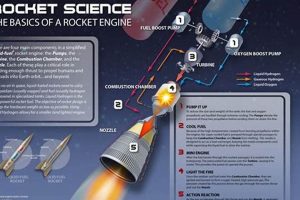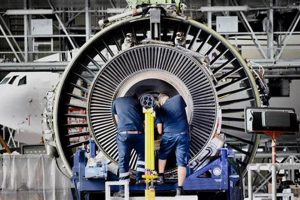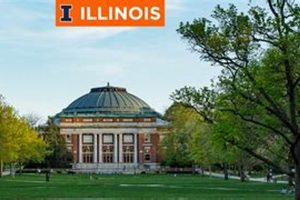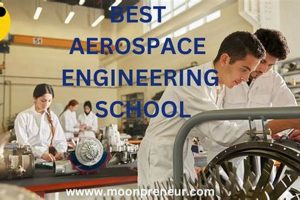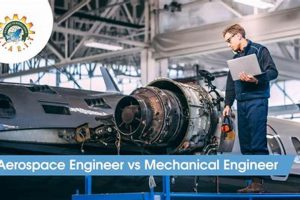Massachusetts Institute of Technology’s OpenCourseWare (OCW) initiative provides freely accessible educational materials from its aerospace engineering curriculum. This program offers a wide array of resources, including lecture notes, assignments, and exams, mirroring content used in actual courses. These materials cover a spectrum of topics within the field, from fundamental principles of aerodynamics and propulsion to advanced studies in spacecraft design and control systems.
The availability of these resources allows individuals globally to engage with high-quality educational content, facilitating self-directed learning and professional development. It provides a valuable opportunity for students, educators, and professionals to deepen their understanding of aerospace engineering principles and practices. Furthermore, the initiative supports the dissemination of knowledge and promotes innovation within the field by making educational materials accessible to a wider audience. It allows access of one of the world’s top aerospace programs to anyone.
The subsequent discussion will explore specific courses and resources available through this initiative, highlighting key learning objectives and potential applications. The courses include introductory material all the way to complex topics.
Tips for Leveraging Resources
The following guidelines are provided to assist individuals in effectively utilizing the educational resources available.
Tip 1: Prioritize Foundational Knowledge: Begin with introductory courses to establish a strong understanding of fundamental principles before progressing to more advanced topics. For example, review basic thermodynamics concepts before studying advanced propulsion systems.
Tip 2: Utilize Problem Sets for Self-Assessment: Work through the provided problem sets and exams to evaluate comprehension and identify areas requiring further study. Compare solutions to gauge accuracy and refine problem-solving techniques.
Tip 3: Supplement with External Resources: Complement these educational materials with textbooks, research papers, and online simulations to broaden perspective and deepen understanding of the subject matter. Look for materials that align with the specific topics being studied.
Tip 4: Engage with Online Communities: Participate in relevant online forums and discussion groups to collaborate with peers, exchange insights, and seek clarification on challenging concepts. Consider platforms dedicated to aerospace engineering or specific sub-disciplines.
Tip 5: Focus on Application-Oriented Learning: Seek opportunities to apply the knowledge gained through these resources to real-world projects or simulations. For instance, use computational fluid dynamics software to model airflow over an airfoil.
Tip 6: Review Lecture Notes Systematically: Thoroughly review the lecture notes provided for each course to ensure a comprehensive understanding of the key concepts and principles. Develop a study schedule to allow ample time for note review.
Tip 7: Explore Interdisciplinary Connections: Recognize the interconnectedness of aerospace engineering with other disciplines, such as mechanical engineering, electrical engineering, and computer science. Explore courses and resources that highlight these interdisciplinary connections.
Effective utilization of these recommendations will enhance learning outcomes and contribute to a deeper understanding of aerospace engineering principles.
The article will conclude with a summary of the key benefits and future implications of open educational resources in aerospace engineering.
1. Accessibility
Accessibility, in the context of MIT OpenCourseWare’s (OCW) aerospace engineering materials, denotes the unrestricted availability of high-quality educational resources to a global audience. This open access removes traditional barriers to education, such as tuition costs, geographical limitations, and formal enrollment requirements. The direct consequence of this accessibility is the democratization of knowledge within aerospace engineering, enabling individuals from diverse backgrounds and circumstances to engage with advanced learning materials. For example, a self-taught engineer in a remote location with limited institutional resources can utilize the same lecture notes, problem sets, and exams as students enrolled at MIT, fostering professional development and contributing to innovation regardless of location or economic status.
The importance of accessibility as a core component of MIT OCW lies in its potential to bridge the educational gap between well-resourced institutions and those lacking similar opportunities. The content within the aerospace engineering discipline encompasses complex mathematical models, intricate design principles, and advanced technological concepts. Access to this knowledge empowers individuals to acquire expertise, contribute to research, and advance the field, regardless of their institutional affiliation. Practically, this means that aspiring aerospace engineers can supplement their formal education or pursue self-directed learning, increasing their competence and potential for career advancement.
In summary, the accessibility of MIT OCW’s aerospace engineering materials fosters a more equitable distribution of knowledge and resources, empowering individuals to pursue their educational and professional aspirations without the traditional constraints of cost or location. This access promotes both individual growth and collective advancement within the field of aerospace engineering. Challenges remain in ensuring that these resources are equally accessible to individuals with disabilities and that sufficient support structures are available for learners who may lack formal educational backgrounds. By further addressing these challenges, the OCW can better ensure equitable access to the information and skills training provided by the program.
2. Comprehensive Curriculum
The comprehensive nature of the curriculum provided through MIT OpenCourseWare for Aerospace Engineering constitutes a fundamental pillar of its value. It extends beyond isolated topics, offering an integrated educational experience mirroring the rigor and breadth of MIT’s on-campus aerospace engineering program. This comprehensiveness enables users to acquire a well-rounded understanding of the field.
- Core Aerospace Disciplines
The curriculum encompasses core aerospace disciplines, including aerodynamics, propulsion, structures, and control systems. Each discipline is presented with a depth that allows learners to grasp fundamental principles and advanced concepts. For instance, aerodynamics courses delve into boundary layer theory, compressible flow, and airfoil design, while propulsion courses cover rocket propulsion, gas turbine engines, and advanced propulsion concepts. This comprehensive coverage ensures that users develop a solid foundation across all critical aspects of aerospace engineering.
- Design and Systems Engineering
Beyond individual disciplines, the curriculum integrates design and systems engineering principles. This includes courses on spacecraft design, aircraft design, and systems architecture. These courses emphasize the importance of integrating different components and subsystems into a cohesive and functional system. Students learn how to translate mission requirements into design specifications, conduct trade studies, and manage the complexities of large-scale engineering projects. The design-oriented courses foster critical thinking and problem-solving skills essential for success in aerospace engineering careers.
- Mathematics and Computation
A significant portion of the curriculum is dedicated to the mathematical and computational tools essential for aerospace engineering analysis. Courses cover differential equations, linear algebra, numerical methods, and computational fluid dynamics (CFD). These courses equip learners with the mathematical skills to model and analyze complex aerospace systems. For example, numerical methods are used to solve equations governing fluid flow and structural behavior, while CFD simulations provide valuable insights into the performance of aerospace vehicles. The strong emphasis on mathematics and computation enables users to perform independent analyses and contribute to cutting-edge research.
- Laboratory and Experimental Work
While MIT OCW primarily delivers theoretical content, it also includes supplementary materials relating to laboratory experiments and experimental methodologies often used in aerospace. This includes descriptions of experimental setups, data analysis techniques, and sample experimental data. These resources provide valuable insights into the practical aspects of aerospace engineering. Although a virtual laboratory experience can’t completely replicate a physical laboratory, access to laboratory exercises supplements the knowledge gained in the theoretical courses. Students who have hands-on laboratory skills will have more real-world understanding of aerospace engineering challenges.
The facets above underscore the value of MIT OpenCourseWare for Aerospace Engineering. The content available enables comprehensive skill development for both those seeking to supplement their formal educational with additional resources and those interested in teaching themselves aerospace engineering concepts and theory.
3. Rigorous Content
The designation “rigorous content” as applied to Massachusetts Institute of Technology’s OpenCourseWare (OCW) in Aerospace Engineering denotes a direct transfer of the academic standards and expectations upheld within MIT’s on-campus degree programs. The OCW materials are not diluted or simplified for broader consumption; rather, they represent a faithful reproduction of the curriculum delivered to enrolled students. This entails a high degree of mathematical sophistication, theoretical depth, and problem-solving intensity. Consequently, engagement with these resources requires a significant commitment to intellectual rigor and a preparedness to grapple with complex concepts. The cause is MIT’s commitment to open access while maintaining academic integrity; the effect is a resource of considerable value, but also one demanding substantial effort from the learner.
The importance of rigorous content lies in its ability to foster genuine understanding and critical thinking, rather than superficial familiarity. For instance, the aerodynamics courses within the Aerospace Engineering OCW present detailed derivations of the Navier-Stokes equations, along with their applications to various flow regimes. Similarly, the control systems courses delve into advanced topics such as optimal control and Kalman filtering, requiring a strong foundation in linear algebra and differential equations. This level of detail challenges learners to develop a deep understanding of underlying principles and to apply those principles to solve realistic engineering problems. This rigorous approach is critical for preparing future aerospace engineers capable of tackling complex challenges in design, analysis, and innovation.
In summary, the rigorous content of MIT OCW’s Aerospace Engineering offerings provides a valuable resource for advanced learning and professional development. While the intensity may present a barrier for some, it simultaneously ensures that those who engage with the material are exposed to the same level of intellectual challenge and academic rigor as MIT students. By maintaining this standard, the OCW contributes to the global dissemination of high-quality aerospace engineering knowledge, fostering innovation and advancing the field worldwide. Challenges to maintaining this level of rigor include ensuring that materials remain current and relevant, and providing adequate support for learners who may lack the prerequisite knowledge or skills.
4. Self-Paced Learning
The availability of Massachusetts Institute of Technology’s OpenCourseWare (OCW) for Aerospace Engineering significantly supports self-paced learning. This modality empowers individuals to control the speed and sequence of their educational journey, adapting the learning experience to their individual needs and circumstances. It is a critical element for those seeking to augment formal education or pursue independent study in the aerospace domain.
- Asynchronous Access to Materials
The OCW platform provides asynchronous access to course materials, including lecture notes, problem sets, and exams. This allows learners to engage with the content at any time and from any location, eliminating the constraints of fixed class schedules. For example, a working professional can study propulsion systems during evenings or weekends, fitting learning around their existing commitments. This flexibility is crucial for individuals who cannot attend traditional classroom-based courses.
- Individualized Learning Paths
Self-paced learning through OCW enables the creation of individualized learning paths. Learners can choose which topics to focus on and in what order, based on their prior knowledge, interests, and career goals. An aspiring aerospace engineer interested in spacecraft design, for instance, can prioritize courses on orbital mechanics, spacecraft propulsion, and attitude control, while deferring other topics. This customized approach maximizes learning efficiency and relevance.
- Opportunity for Repetition and Review
The self-paced format allows learners to repeat and review materials as needed to solidify their understanding. They can revisit challenging concepts multiple times, working through problem sets until they achieve mastery. This contrasts with traditional classroom settings, where the pace is often dictated by the instructor and opportunities for repetition may be limited. The ability to self-regulate the learning process promotes deeper understanding and retention.
- Independent Assessment and Feedback
While MIT OCW typically does not offer direct feedback or grading, the provided problem sets and exams serve as tools for self-assessment. Learners can gauge their progress by attempting these assessments and comparing their solutions to the provided answers. This independent assessment process encourages self-reflection and helps identify areas where further study is required. The absence of external grading promotes intrinsic motivation and a focus on learning for understanding, rather than for a grade.
These facets collectively illustrate the synergy between self-paced learning and access to open educational resources such as MIT OCW for Aerospace Engineering. These aspects enable flexible, customized, and effective learning experiences for a global audience, ultimately contributing to the advancement of aerospace engineering knowledge and skills.
5. Global Reach
The concept of “Global Reach,” when linked to MIT OpenCourseWare (OCW) in Aerospace Engineering, signifies the program’s capacity to disseminate educational resources beyond geographical boundaries. This reach extends the impact of MIT’s aerospace engineering curriculum to a worldwide audience, democratizing access to advanced knowledge. The primary cause of this global accessibility is MIT’s commitment to open education, coupled with the internet’s capacity for unrestricted information distribution. The resultant effect is that individuals, regardless of their location or institutional affiliation, can engage with materials comparable to those used in MIT’s on-campus courses. The importance of this global reach is evident in its potential to elevate the quality of aerospace engineering education and practice globally. For instance, educators in developing countries can leverage these resources to enhance their teaching methodologies and curriculum design. Similarly, professionals can use the material for upskilling, allowing for innovation in diverse settings.
Consider the practical application of this “Global Reach” through specific examples. A research team in South America might utilize MIT OCW’s materials on computational fluid dynamics to improve the design of wind turbines, leading to more efficient renewable energy systems. Or, a group of engineering students in Southeast Asia could use the course notes on satellite communications to develop innovative solutions for rural connectivity. These examples highlight the far-reaching implications of providing open access to high-quality educational resources. It allows for global knowledge sharing and collaborative problem-solving, driving innovation in multiple domains.
In summary, the “Global Reach” of MIT OCW Aerospace Engineering is a crucial element that empowers individuals and institutions worldwide. By providing unrestricted access to educational materials, the program enhances learning, promotes innovation, and contributes to the advancement of aerospace engineering knowledge on a global scale. While challenges, such as ensuring equitable access to technology and internet connectivity, remain, the program’s impact is undeniable. The worldwide educational community receives a powerful asset, assisting the development of innovative engineers who can shape the future of aerospace engineering and related sectors.
6. Knowledge Dissemination
Knowledge dissemination, concerning MIT OpenCourseWare in Aerospace Engineering, signifies the deliberate and systematic distribution of educational content to a broad audience. This distribution extends beyond traditional academic boundaries, impacting students, educators, and professionals globally. The value of this dissemination stems from its capacity to democratize access to high-quality educational resources.
- Open Access to Course Materials
The primary mechanism for knowledge dissemination is the open provision of course materials, including lecture notes, problem sets, and examinations. This unrestricted access enables individuals to engage with content equivalent to that used in MIT’s on-campus courses. An educator at a less-resourced institution, for example, can utilize these materials to enhance their curriculum, thereby expanding the reach of MIT’s educational expertise. This eliminates the barriers of enrollment costs and physical location.
- Global Educational Resource
Dissemination facilitates the creation of a global educational resource. The accessibility of aerospace engineering content from MIT OCW allows learners worldwide to supplement their formal education or pursue self-directed study. A student in a developing nation, for instance, can access advanced topics in spacecraft design, broadening their knowledge base and potentially contributing to local technological advancements. Knowledge dissemination facilitates a community with resources from a top university, regardless of their location.
- Promotion of Research and Innovation
The wide availability of advanced course materials promotes research and innovation within the field of aerospace engineering. Researchers can leverage the content to explore new topics, validate findings, and develop novel solutions. Access to detailed lecture notes on advanced propulsion systems, for example, could stimulate new research directions and lead to improved engine designs. Dissemination fosters research and development across global communities, accelerating progress.
- Enhanced Professional Development
Knowledge dissemination supports ongoing professional development for engineers and practitioners in the aerospace industry. By providing access to cutting-edge content, MIT OCW allows professionals to stay abreast of the latest developments and enhance their technical skills. An engineer working on aircraft design, for instance, can access materials on computational fluid dynamics to improve their modeling techniques, leading to more efficient and safer aircraft designs. The benefit for the industry by keeping engineers up to date in skills and techniques.
These facets illustrate the significance of knowledge dissemination in expanding the impact of MIT OpenCourseWare for Aerospace Engineering. The open sharing of materials promotes educational advancement, fosters innovation, and supports professional growth across the global aerospace community. The continuous updating and expansion of these resources further amplifies their long-term value.
Frequently Asked Questions
The following section addresses common inquiries regarding the Massachusetts Institute of Technology OpenCourseWare (OCW) resources for aerospace engineering.
Question 1: What is the scope of topics covered within the MIT OCW Aerospace Engineering program?
The curriculum spans fundamental principles to advanced subjects, including aerodynamics, propulsion, aerospace structures, flight vehicle engineering, orbital mechanics, and related topics. Course materials mirror the content delivered in MIT’s on-campus aerospace engineering programs.
Question 2: Are the resources available through MIT OCW Aerospace Engineering entirely free of charge?
Access to all lecture notes, problem sets, solutions, and examinations is provided at no cost. However, MIT OCW does not grant degrees, offer academic credit, or provide direct instructor support.
Question 3: What level of mathematical proficiency is recommended for engaging with MIT OCW Aerospace Engineering materials?
A strong foundation in calculus, differential equations, linear algebra, and introductory physics is highly advisable. Certain courses may require familiarity with numerical methods and programming.
Question 4: Does MIT OCW Aerospace Engineering provide any form of certification or accreditation upon completion of course materials?
No official certification or accreditation is offered. MIT OCW serves as a self-study resource, and users are responsible for independently validating their knowledge and skills.
Question 5: How frequently are the MIT OCW Aerospace Engineering materials updated to reflect current advancements in the field?
The update frequency varies depending on the specific course and its content. While some materials may be regularly revised, others may reflect the state of knowledge at the time of their original publication. Users should consider supplementing their learning with current research publications and industry resources.
Question 6: Is technical support available to assist users navigating or understanding the MIT OCW Aerospace Engineering materials?
MIT OCW does not provide direct technical support. Users are expected to independently resolve any technical issues or conceptual difficulties encountered while accessing or utilizing the materials.
These FAQs offer clarification on the characteristics and limitations of using MIT OCW’s aerospace engineering resources.
The subsequent article will delve into potential career paths for individuals utilizing MIT OCW Aerospace Engineering for self-study.
Conclusion
This article has detailed the multifaceted benefits of mit ocw aerospace engineering, emphasizing its role in democratizing access to high-quality educational resources. The comprehensive curriculum, rigorous content, support for self-paced learning, global reach, and facilitation of knowledge dissemination collectively contribute to the advancement of aerospace engineering education worldwide. Its accessibility promotes learning across institutional boundaries and creates new opportunities.
The sustained utilization of mit ocw aerospace engineering promises to cultivate a more informed and skilled global aerospace workforce, better equipped to address the complex technological challenges of the future. Continued engagement with these resources by educators, students, and professionals is encouraged to further amplify their positive impact on the field.


![Does Columbia Offer Aerospace Engineering? [Find Out!] Innovating the Future of Flight with Reliable Aviation Solutions Does Columbia Offer Aerospace Engineering? [Find Out!] | Innovating the Future of Flight with Reliable Aviation Solutions](https://mixaerospace.com/wp-content/uploads/2025/10/th-947-300x200.jpg)
